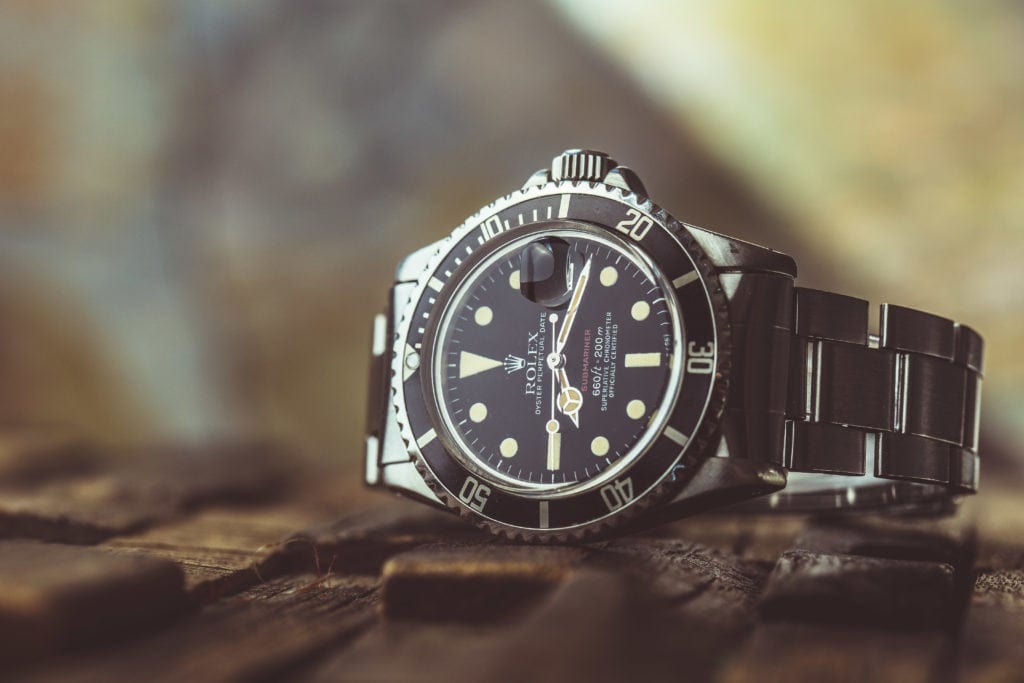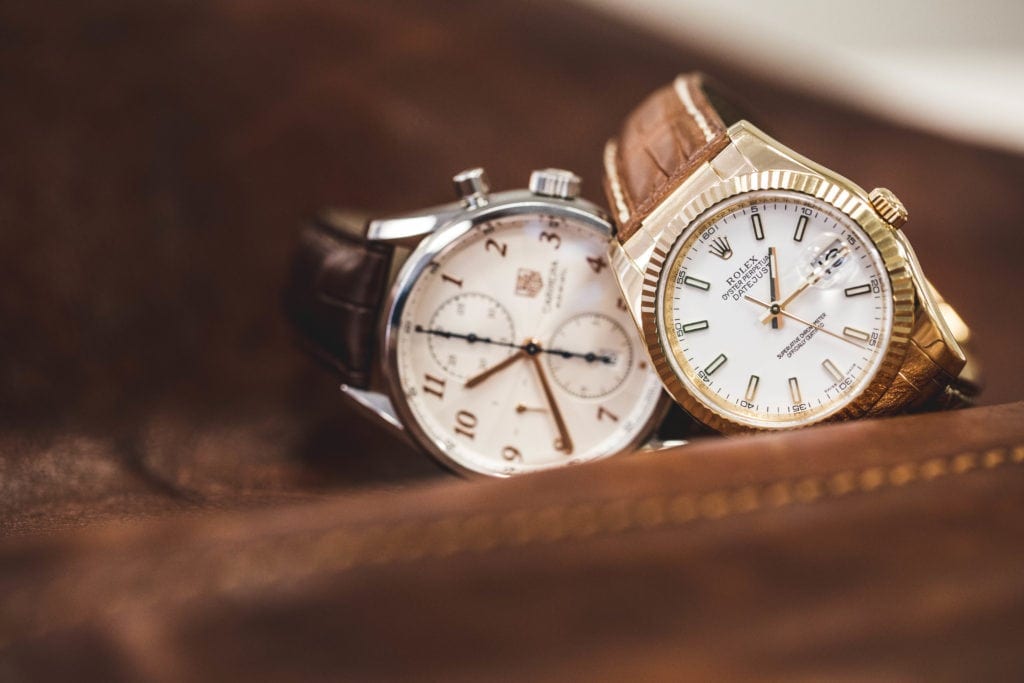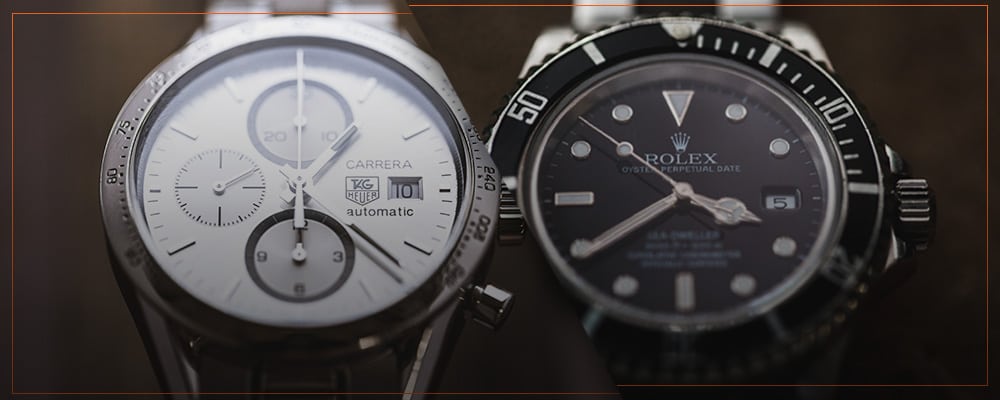TAG Heuer vs. Rolex: A Brand Comparison
TAG Heuer and Rolex are two very different brands who produce very different timepieces. However, even with their unique approaches to watchmaking, they may have more in common than you think. For instance, both Rolex and TAG Heuer make some of the world’s most famous racing watches. Let’s look at the two brands side-by-side to help you choose the best brand for you. Here, we’ll dive into an in-depth brand comparison of TAG Heuer vs. Rolex.
TAG Heuer vs. Rolex in the Early Days

Eduoard Heuer founded the Heuer brand in 1860. Nearly half a century later, Hans Wilsdorf and his brother-in-law, Alfred Davis, founded Rolex in 1905. In their first decades of business, both TAG Heuer and Rolex developed important advancements that major watchmakers continue to use. For example, in 1887, Heuer filed a patent for an oscillating pinion mechanism. This technology still appears in modern watches. Later, in 1931, Rolex patented the world’s first perpetual self-winding mechanism, a crucial system to automatic watches today. Although the brands established over four decades apart, looking at TAG vs. Rolex in their early days still makes for an interesting comparison.
TAG Heuer Early Achievements
TAG Heuer’s oscillating pinon mechanism was the first of many achievements for the brand. In 1895, they filed another patent, this time for their first water resistant case. Into the twentieth century, they continued to innovate. In 1916, they notched another milestone with the Micrograph, the most accurate stopwatch of the time. Their successes continued through the mid-1900s. In 1949, they launched their first watch with a tide indicator, the Solunar. A year later, they introduced the Seafarer, the world’s first chronograph with a tide level indicator and dial for regattas. In 1962, TAG Heuer made history by becoming the first Swiss watchmaker in space. However, it was 1969 that the brand solidified its place as a true pioneer in the industry. That year, TAG Heuer, along with Breitling, Buren, and Dubois-Depraz unveiled the world’s first self-winding chronograph movement, the Chronomatic.

Rolex Early Milestones
Rolex also has a number of early achievements to their name. After just five years of business, they became the first brand to have a watch chronometer certified. Their successes continued into the next decade with the creation of the first water resistant wristwatch in 1926: the Oyster. Like the Oyster, Rolex developed some of their most significant and iconic watches early on. 1945 marked the release of the Datejust, the first self-winding wristwatch to display the date on the dial. In 1953, they launched the first dive watch water resistant up to 100 meters: the Submariner. A year later came the GMT Master, the first watch allowing you to read the time in multiple time zones. Finally, in 1956, Rolex introduced the Day-Date, the first wristwatch to display the date and day of the week in a window on the dial. Later, the 18-karat yellow gold variation of this model would eventually garner the nickname, the President.
TAG Heuer vs. Rolex Partnerships and Impact
It’s also worth looking at TAG Heuer vs. Rolex outside of the watch industry. TAG Heuer’s primary focus has been within the automobile industry since the early 1900s. In 1911, they patented their first dashboard chronograph called Time of Trip. A couple decades later in 1933, they debuted the first Autavia. This dashboard clock featured a timer function that could run an impressive eight days without winding. Into the 1940s and 50s, Heuer expanded their offerings from land to sea. However, in the 1960s, they refocused on the automobile industry. In 1963 and later in 1969, they unveiled two of their most iconic models: the Carrera and Monaco, respectively. By 1992, they had become the official timekeeper for Formula 1 racing. This partnership further solidified their presence in the automobile industry, one that continues today.
Over the years, Rolex has also cultivated countless high-profile partnerships across an array of industries. The brand has been present at some of the most significant moments in golf, tennis, yachting, and equestrian races. They serve as official timekeeper and sponsor of several golf majors and tennis grand slam tournaments, among numerous others. They’ve also worked with prominent organizations like National Geographic to support underwater and mountain exploration. In addition, Rolex has made an impact in the areas of art and science.
TAG Heuer’s and Rolex’s profound presence has made a lasting impact on our culture. TAG Heuer’s Monaco quickly grew to fame in the 1970s. In 1970, legendary actor and racer Steve McQueen wore the model while making the film Le Mans. Since then, their roster of ambassadors has expanded, including celebrities like Chris Hemsworth. Rolex is no different. Some of the most influential world leaders, filmmakers, entertainers, and athletes proudly wear their watches. A few of their ambassadors include Tiger Woods, James Cameron, and Roger Federer among countless others.
TAG Heuer – Most Popular Watches and Prices
The previously mentioned Carrera and Monaco are undeniably two of TAG Heuer’s most famous sport and racing chronographs. However, since these collections debuted in the 1960s, the brand has produced several other iconic models. The 1970s marked the launch of both the Silverstone and the Monza. TAG Heuer initially released the Silverstone as a replacement for the Monaco. Nevertheless, the Monaco ultimately returned to the brand’s catalog two decades later in 1998. Similarly, TAG Heuer first released the Monza as a limited edition variation of the Carrera. They went on to produce the model until 1985. After a brief retirement, they brought it back in the new millennium.
Into the 1980s, TAG Heuer introduced the Professional, Formula 1, and Link collections. The Professional series came right in the midst of the Quartz Crisis. This collection would later become the Aquaracer in 2005. 1980 also marked the year TAG Heuer began their longstanding partnership with Formula 1. Fast forward to 1986, the industry was recovering from the quartz craze, and Techniques d’Avant Garde had just acquired Heuer. They needed a new collection to re-establish a presence for the brand and that collection was the Formula 1. A year later, they launched the Link family of watches.
The new millennium also brought the debut of three of TAG Heuer’s most popular watches. In 2004, they released the first model in the SLR collection. This marked the first official, collaboratively designed watch between TAG Heuer and the McLaren Mercedes Formula 1 Team. A year later, the Professional series made a comeback in the form of the Aquaracer. Then, in 2007, TAG Heuer built upon the iconic Carrera line with the debut of the Grand Carrera.

Rolex – Most Popular Watches and Prices
We’ve already covered a number of Rolex’s most popular watches. However, these are only a handful among the brand’s many iconic designs. Shortly after the Oyster came the Cellini in 1928. The model was a bit of a departure from the brand’s typical sport and tool watches. However, it helped to diversify their catalog with a dress watch option. A few years later, Rolex released the Bubbleback, which was one of the first fully functional automatic watches. As technology improved, Rolex eventually phased the model out of their catalog. Still, it continues to be a favorite among collectors.
The same year as the Datejust, Rolex also released the Air-King as part of the Air Series. Today, the Air-King is the only remaining model from this collection. In 1953, Rolex debuted the Submariner and Explorer, which was one of the first watches to reach Everest’s peak. Three years later, Rolex launched the Milgauss. In order to develop this unique, anti-magnetic model, they partnered with CERN, the European Organization for Nuclear Research. Then, in 1963, the same year TAG Heuer unveiled the Carrera, Rolex introduced the Daytona as their first official collection of chronographs.
In the latter half of the 1960s, Rolex began to modernize and reinvent some of their most beloved collections. They began in 1967 with the Sea-Dweller, which built upon the design of the Submariner but added stronger capabilities. In 2008, the all-new Deepsea would go on to replace the Sea-Dweller as the brand’s most robust dive watch. Rolex continued with this trend into the next decade with the Explorer II. It featured a sportier and more rugged build than the original. Toward the latter half of the 1970s, Rolex added quartz variations of the Datejust and Day-Date, forming the Oysterquartz collection. Next, the brand reimagined the GMT Master in 1983 with the GMT Master II. Most notably, the GMT Master II comes equipped with a 24-hour GMT hand. This allows you to read three different time zones.
In 1992, Rolex finally released a brand new collection to their lineup: the Yacht-Master. Nearly two decades later, they would go on to update this collection as well. The Yacht-Master II boasts two notable upgrades: a larger size and the addition of a regatta timer. Into the new millennium, Rolex reinvented the Datejust line in 2009. The Datejust II is a more streamlined and contemporary version of the classic. Then, in 2012, Rolex welcomed another new collection to their catalog: the Sky Dweller. The model showcased the brand’s first entirely new movement featuring an entirely new complication in two decades.
TAG Heuer vs. Rolex: Aesthetic vs. Function
TAG Heuer and Rolex both have an array of popular models and a strong cultural impact. However, when looking at TAG vs. Rolex in terms of their watches themselves, there are some key aesthetic and functional differences. To compare, let’s match up two of their sport and racing watches. Rolex broke into the automotive industry in the mid-1930s. Famed racer Sir Malcolm Campbell set a new land speed record in 1935 wearing an Oyster Perpetual. However, Heuer became a major player in motorsports by the latter half of the twentieth century. For them, it began with their dashboard chronographs and later transitioned to wristwatches.
1963 was an important year for both Rolex and TAG Heuer. It marked the debut of both the Daytona and the Carrera respectively. The Daytona was Rolex’s first official collection of chronographs. Its creation came shortly after the brand started their sponsorship of the 24 Hours of Daytona race, later renamed the Rolex 24 at Daytona. At the time, TAG Heuer already had a range of Chronographs called the Autavia. However, they felt they needed to offer something new, and the Carrera was born. Upon their initial releases, both models saw much success. Here, we’ll breakdown everything you need to know about choosing a Daytona vs. a Carrera.
Though the Daytona line launched in 1963, it wasn’t until 1965 that the Daytona name initially appeared on the dial. For two years, the collection was simply the Cosmograph. The first Cosmograph Reference 6239 introduced a number of firsts for Rolex. One of the most notable is the now iconic panda dial. It showcased contrasting black subdials against a white dial. It was also the first model with a tachymeter scale engraved on the bezel instead of printed on the dial. Toward the end of the 1970s, Rolex started to make changes to the design. Instead, Rolex transitioned to the silver and black Daytonas we typically think of today.
Despite the significant changes in aesthetic, the most important update to the Daytona came in the form of the movement. Early models came equipped with a manual Valjoux-sourced chronograph caliber. However, with the development of the automatic chronograph in 1969, Rolex knew they needed to update the Daytona. Zenith, one of the first creators of the automatic chronograph, soon approached Rolex. Rolex was interested but only if the brand would revive their historic El Primero movement. It took nearly a decade of development along with hundreds of modifications.
Eventually, Zenith presented a design Rolex deemed worthy for the Daytona. In 1988, they debuted the first automatic variation of the model. By the new millennium, the Daytona received another functional improvement. Rolex was beginning to upgrade all its models with in-house movements. In 2000, they released a new Daytona series featuring their own Caliber 4130.
The origins of the Carrera are inextricably linked with one man: Jack Heuer. Jack is the great grandson of the brand’s founder, Eduard Heuer. He’d just taken over the company in 1962 and spurred the creation of the Carrera, beginning with the Reference 2477. Early Carreras featured a completely uniform dial as opposed to one with contrasting chronograph registers. In addition, they housed a Valjoux 72 movement. The Carrera remained one of the most popular models in the brand’s catalog for two decades. Then, its fate began to shift.
Jack Heuer retired in 1982 and with him, the Carrera. Three years later in 1985, another big transition came for the Heuer brand. Techniques d’Avant Garde acquired them, and they officially became TAG Heuer. Instead of seeking to overhaul the company, the new leadership wanted to do just the opposite. They focused on heritage and tradition. They wanted to get back to Heuer’s roots and bring back the Carrera.
TAG Heuer couldn’t bring themselves to revive the Carrera in earnest without the man who’d brought it to life. So, they approached Jack Heuer about returning to relaunch the model. He graciously agreed, and in 1996, the Carrera was reborn. The initial reissue lacked any major aesthetic updates. The brand wanted to make the model as close to the original as possible, from the dial layout to the old Heuer logo. However, it did receive an upgrade under the hood. The new Carrera came equipped with a Lemania 1873 hand-wound caliber. Soon after, TAG Heuer updated the Carrera with an automatic chronograph movement from ETA. Still, it wouldn’t be until 2014 that the brand would introduce their first in-house caliber to the Carrera collection. That year they debuted the Carrera 1887 41mm Chronograph with their new Caliber 1887 movement.
Choosing a Rolex vs. TAG Heuer Watch
In their first years of business, both TAG Heuer and Rolex asserted themselves as pioneers in the industry. They both focused on securing key patents and innovating new technologies. Over the years, each brand has carved their own unique place in our culture through key partnerships. As a result, they’ve become two of the premier producers of sport and tool watches.
TAG Heuer and Rolex’s presence in the industry and our world is indisputable. The iconic Rolex crown undoubtedly carries a certain weight. It’s a symbol of tradition and prestige. However, if you’re an automobile or racing fan, you can’t deny TAG Heuer’s rich history in the field. Plus, in recent years, the brand has become more progressive and adaptable to new technologies. Not long ago, they introduced their first smartwatch, the TAG Heuer Connected. Ultimately, when it comes to deciding between TAG vs. Rolex, the biggest difference can come down to price. Rolex tends to carry a higher price tag, which is evident through models like the Daytona. On the other hand, TAG Heuer watches, like the Carrera, can be more attainable.
Get More Articles Like This in Your Inbox
We're constantly creating great content like this. So, why not get it delivered directly to your inbox? By subscribing you agree to our Privacy Policy but you can unsubscribe at any time.







Elaine P | May 4, 2019
|
Thanks , Nice to know the history. I appreciate both brands better now….so in the end, what is WITHIN My means
Green wOOD | March 12, 2019
|
Both Tag Heuer and Rolex are good brands, and their watches are built to serve different purposes. However, if I have to choose between a Rolex watch and Tag Heuer, I will possibly go for a Rolex.
Eric Maroncelli | September 30, 2018
|
Not a complete waste of time to read, but close… have an opinion. Tag vs rolex… YOur conclusion: THEY’RETHEY’RE Both good. Lol STUpid
Rachel Butler | October 16, 2018
|
Eric,
They are both great brands for different reasons. Which is your fav?